
Native Americans, also known as American Indians, Indigenous Americans and other terms, are the indigenous peoples of the United States, except Hawaii. There are over 500 federally recognized tribes within the US, about half of which are associated with Indian reservations. The term "American Indian" excludes Native Hawaiians and some Alaska Natives, while Native Americans are American Indians, plus Alaska Natives of all ethnicities. Native Hawaiians are not counted as Native Americans by the US Census, instead being included in the Census grouping of "Native Hawaiian and other Pacific Islander".
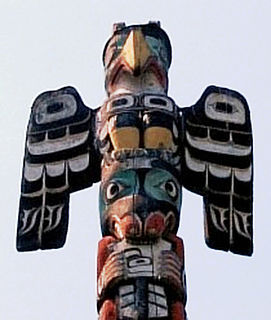
The thunderbird is a legendary creature in certain North American indigenous peoples' history and culture. It is considered a supernatural being of power and strength. It is especially important, and frequently depicted, in the art, songs and oral histories of many Pacific Northwest Coast cultures, but is also found in various forms among some peoples of the American Southwest, East Coast of the United States, Great Lakes, and Great Plains.
The Cherokee are one of the indigenous people of the Southeastern Woodlands. Prior to the 18th century, they were concentrated in southwestern North Carolina, southeastern Tennessee, and the tips of western South Carolina and northeastern Georgia.

The Algonquian languages are a subfamily of Native American languages which includes most of the languages in the Algic language family. The name of the Algonquian language family is distinguished from the orthographically similar Algonquin dialect of the indigenous Ojibwe language (Chippewa), which is a senior member of the Algonquian language family. The term "Algonquin" has been suggested to derive from the Maliseet word elakómkwik, "they are our relatives/allies". A number of Algonquian languages, like many other Native American languages, are now extinct.
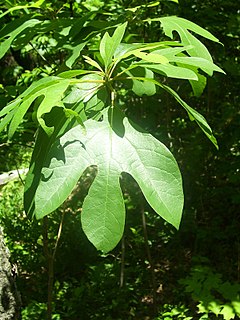
Sassafras is a genus of three extant and one extinct species of deciduous trees in the family Lauraceae, native to eastern North America and eastern Asia. The genus is distinguished by its aromatic properties, which have made the tree useful to humans.

Sciurus carolinensis, common name eastern gray squirrel or grey squirrel depending on region, is a tree squirrel in the genus Sciurus. It is native to eastern North America, where it is the most prodigious and ecologically essential natural forest regenerator. Widely introduced to certain places around the world, the eastern gray squirrel in Europe, in particular, is regarded as an invasive species.

The fur trade is a worldwide industry dealing in the acquisition and sale of animal fur. Since the establishment of a world fur market in the early modern period, furs of boreal, polar and cold temperate mammalian animals have been the most valued. Historically the trade stimulated the exploration and colonization of Siberia, northern North America, and the South Shetland and South Sandwich Islands.

Pinus strobus, commonly denominated the eastern white pine, northern white pine, white pine, Weymouth pine (British), and soft pine is a large pine native to eastern North America. It occurs from Newfoundland, Canada west through the Great Lakes region to southeastern Manitoba and Minnesota, United States, and south along the Appalachian Mountains and upper Piedmont to northernmost Georgia and perhaps very rarely in some of the higher elevations in northeastern Alabama.
Paw Paw, Paw paw, or pawpaw may refer to:

The Caddoan languages are a family of languages native to the Great Plains. They were spoken by tribal groups of the central United States, from present-day North Dakota south to Oklahoma. In the 21st century, they are critically endangered, as the number of native speakers has declined markedly.

The brook trout is a species of freshwater fish in the char genus Salvelinus of the salmon family Salmonidae. It is native to Eastern North America in the United States and Canada, but has been introduced elsewhere in North America, as well as to Iceland, Europe, and Asia. In parts of its range, it is also known as the eastern brook trout, speckled trout, brook charr, squaretail, or mud trout, among others. A potamodromous population in Lake Superior, as well as an anadromous population in Maine, is known as coaster trout or, simply, as coasters. The brook trout is the state fish of nine U.S. states: Michigan, New Hampshire, New Jersey, New York, North Carolina, Pennsylvania, Vermont, Virginia, and West Virginia, and the Provincial Fish of Nova Scotia in Canada.
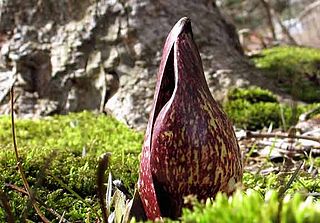
Symplocarpus foetidus, commonly known as skunk cabbage or eastern skunk cabbage, is a low growing plant that grows in wetlands and moist hill slopes of eastern North America. Bruised leaves present a fragrance reminiscent of skunk.

Muskogean is language family spoken in different areas of the Southeastern United States. Though there is an ongoing debate concerning their interrelationships, the Muskogean languages are generally divided into two branches, Eastern Muskogean and Western Muskogean. Typologically, Muskogean languages are agglutinative. One language, Apalachee, is extinct and the remaining languages are critically endangered.
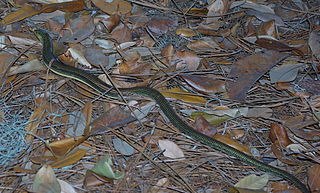
A glass lizard is a member of a number of lizard species that belong to the family Anguidae. They are native to Central and South America, Asia, and north Africa.
The Container Revolution is the introduction of pottery into the Eastern Woodlands of North America during the Archaic period. As these societies became more sedentary, they were able to manufacture and use vessels that would have broken during transportation. Pots allowed for more efficient processing of wild seeds, which created less work for people when the pots were made waterproof. More-efficient seed collection systems and the deliberate manipulation of the native plants, in turn led to the domestication of several plant species. This is just one of many cultural developments that began during this time.

Vaccinium corymbosum, the northern highbush blueberry, is a North American species of blueberry which has become a food crop of significant economic importance. It is native to eastern Canada and the eastern and southern United States, from Ontario east to Nova Scotia and south as far as Florida and eastern Texas. It is also naturalized in other places: Europe, Japan, New Zealand, the Pacific Northwest of North America, etc. Other common names include blue huckleberry, tall huckleberry, swamp huckleberry, high blueberry, and swamp blueberry.

The Eastern Agricultural Complex was one of about 10 independent centers of plant domestication in the pre-historic world. By about 1,800 BCE the Native Americans of North America were cultivating for food several species of plants, thus transitioning from a hunter-gatherer economy to agriculture. After 200 BCE when maize from Mexico was introduced to what is now the eastern United States, the Native Americans of the present-day United States and Canada slowly changed from growing indigenous plants to a maize-based agricultural economy. The cultivation of indigenous plants declined and was eventually abandoned, the formerly domesticated plants reverting to their wild forms.
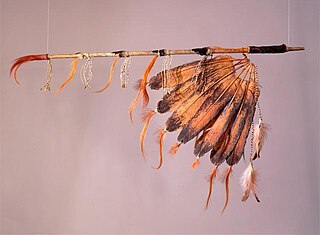
A ceremonial pipe is a particular type of smoking pipe, used by a number of Native American cultures in their sacred ceremonies. Traditionally they are used to offer prayers in a religious ceremony, to make a ceremonial commitment, or to seal a covenant or treaty. The pipe ceremony may be a component of a larger ceremony, or held as a sacred ceremony in and of itself. Indigenous peoples of the Americas who use ceremonial pipes have names for them in each culture's indigenous language. Not all cultures have pipe traditions, and there is no single word for all ceremonial pipes across the hundreds of diverse Native American languages.
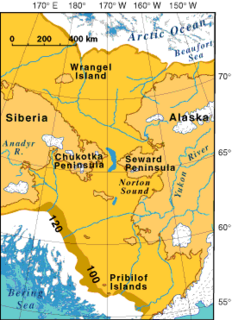
The Ancient Beringians (AB) is a specific archaeogenetic lineage, based on the genome of an infant found at the Upward Sun River site, dated to 11,500 years ago. The AB lineage diverged from the Ancestral Native American (ANA) lineage about 20,000 years ago. The ANA lineage was estimated as having been formed between 20,000 and 25,000 years ago by
a mixture of Proto-Mongoloid and used to be thought to have Ancient North Eurasian lineage, consistent with the model of the peopling of the Americas via Beringia during the Last Glacial Maximum. The Ancient Beringian lineage is extinct, and is not found as a contribution to modern indigenous lineages in Alaska. The 2018 study suggests that the AB lineage was replaced by or absorbed in a back-migration of NNA to Alaska. The modern Athabaskan populations are derived from an admixture of this NNA back-migration and a Paleo-Siberian lineage before about 2,500 years ago.

Florida is host to many types of fauna



















